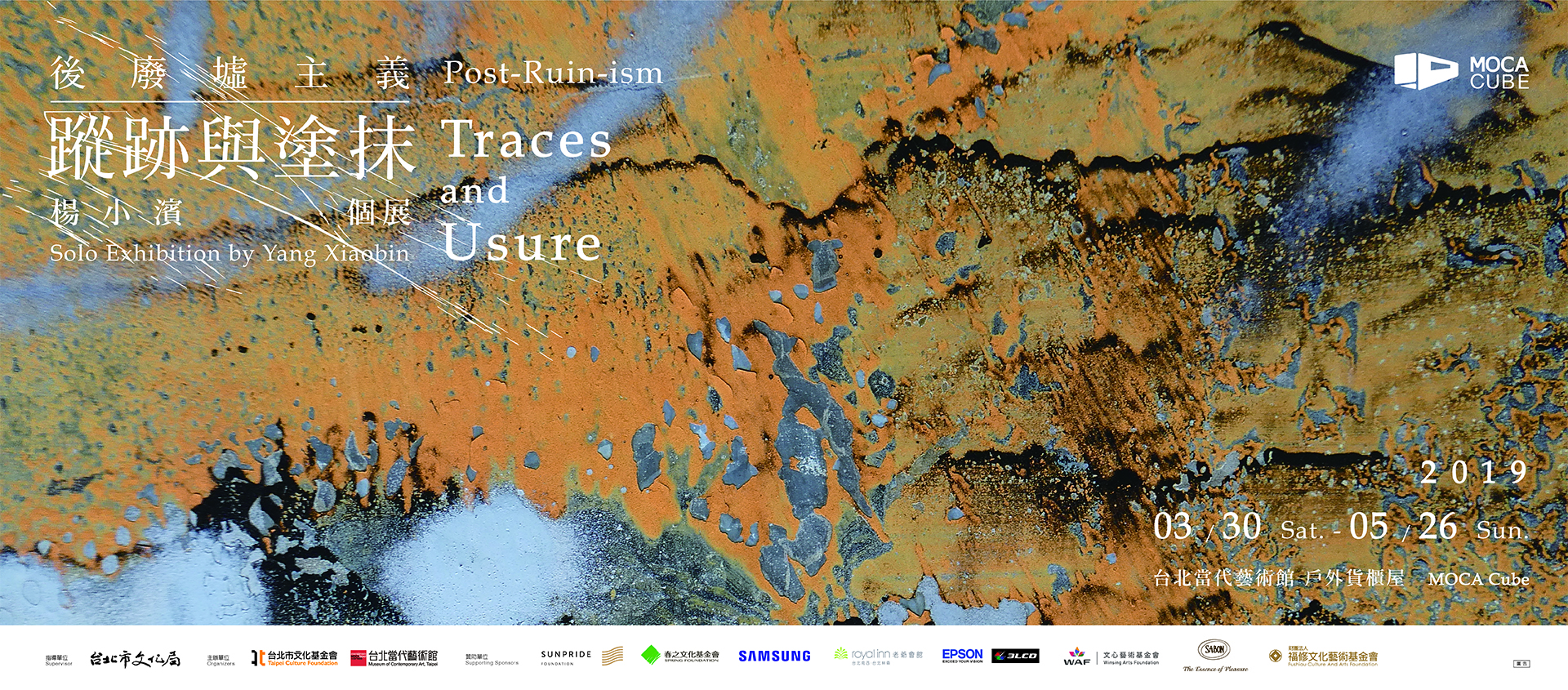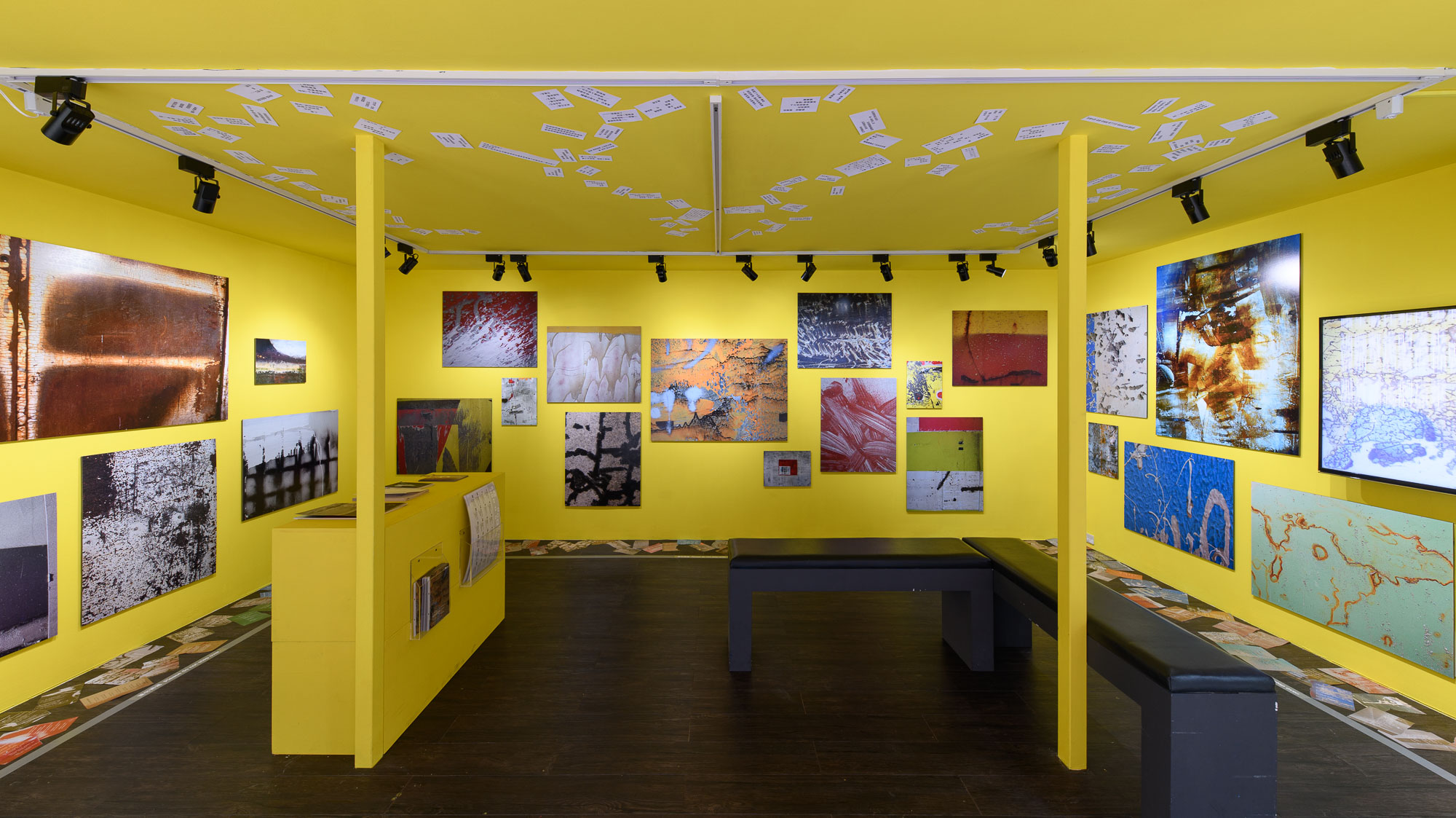

台北當代藝術館 官方網站 Museum of Contemporary Art, Taipei
Wednesday 星期三
10AM - 6PM



Wednesday 星期三
10AM - 6PM
EXHIBITIONS & EVENTS 展覽活動

2019 / 03 / 30 Sat.
2019 / 05 / 26 Sun.
地點
venue
MoCA Cube

【【後廢墟主義:關鍵詞】】 楊小濱 【壞】 只要有人在,就有壞。人在世界上創建的同時也亂弄了世界。後廢墟主義的視景是被弄亂、弄壞的世界角落。 【後抽象藝術】 讓街巷裡或工地上無意中存在的康丁斯基、米羅、波洛克、塔皮埃斯、羅斯科顯形。 【抽象/具象】 不管是蒙德里安的抽象方塊和線條,還是梵谷的具象向日葵或星空,說到底,都是物質的顏料。後抽象藝術,面對的其實也是具體的牆面、門面、圍籬上所留下的具體的刮痕、油漆、粉刷…或天曉得什麼東西—但正是這些物質性的存在構成了對象。客觀物質不是主觀意念。不過,正是具體的物質,顯現出抽象的容貌。 【蹤跡】 蹤跡一詞來自德希達的概念trace。蹤跡:掩蓋不住的歷史。歷史總是從不經意的地方剝落出來。 【塗抹】 塗抹來自德希達另一個概念usure。塗抹:對歷史的刪改。被刪改的歷史不經意地露出更多印跡。歷史總是一種在擦拭、塗抹的過程中顯現出另樣的圖景。無獨有偶,拉岡也創造了lituraterre(搵學)一詞來開拓出擦拭的空間。 【命名(後廢墟)】 廢墟是現實世界的壞。壞了之後的現實世界,便是現代藝術最常見的主題。班雅明的天使目睹了歷史廢墟上積聚的碎片殘屑被救贖的風暴捲上天空。 【命名(後傷口)】 傷口是肉體的壞。壞了之後的肉體,便成為現代藝術意義上的肉體。 【命名(主義)】 為什麼社會可以主義?為什麼共產可以主義?為什麼資本可以主義?為什麼帝國可以主義?為什麼現代可以主義?為什麼現實可以主義?為什麼象徵可以主義?為什麼殖民可以主義?主義的氾濫是二十世紀以來,政治與文化的異象。那麼,就讓它更加氾濫吧。多談點主義,直到談濫。 【命名(語氣詞、象聲詞)】 我們的哀歎(唉),我們的喘息(吁),我們的驚訝(呀),我們的哭泣(嗚),我們的癡狂(嗷),我們的不屑(呸),我們的疑惑(咦),我們的無奈(呃),我們的手勢(啪、嗒),我們的唇舌(噗、哧)……所有這些關乎我們情感和肉體的,不是更值得一種主義的理念去張揚嗎? 【隨意】 不攝取有意的藝術行為。只有不經意的、隨機留下的痕跡才是對象。 【無風格】 但殘破也可以是一種風格。上帝有風格嗎?上帝創造的猴子和魚和孔雀,能是同一種風格嗎?(或,作為上帝的造物,有機體也可以是一種風格?) 【遊戲】 沒有目的,也可以說是一種無意義的玩耍。馬克思的理想在這裡終於實現了:勞動不再是生產,而是……。 【懶藝術(或拾荒)】 既然已經有人把它做好又棄置了,我又何必在畫布上費勁呢?攝取不是竊取,只是拾荒。 【主體】 誰是後廢墟主義的主體?假如欲望主體執行的是他者的欲望(拉岡),主體性也就意味著對他者欲望形態的完成。如果說有其筆墨氣韻,那正烙印了他者的身體欲望表達。 【業餘】 業餘的設備和技法與拍攝物件的廢棄感、隨意感是相應的。正如業餘的布希亞(法國哲學家)用相機揭示了物質世界的抽象意味。拍攝意義上的業餘體現出美學意義上的專業。 【日常】 不崇尚日常。而是攫取日常視像語言元素裡所潛在的前衛性。從根本上是反日常的,因為日常掩蓋了生活的奇異/歧義。從這個意義上,後廢墟主義的行為是一種「去蔽」(aletheia)。 【底層(群眾藝術?)】 不具備道德感。不替底層發聲。只是常常將底層、草根的行為結果作為藝術保留下來:工地民工的塗料、修車匠的噴漆、清潔人員的粉刷、流浪少年的鑿孔、搬運工的撞擊……。 【聽覺】 你甚至可以聽見在鐵門表面被刮擦的刺耳聲,或者水泥濺上圍籬時發出的嘩啦啦巨響,或者夜半時分牆面上的彩色廣告被胡亂撕下的窸窣聲。 【現成品(非原創)】 杜象讓我們可以把一切現實中死去的變成藝術中鮮活的。後廢墟主義意味著攝取或抓取,抓取現實中「有意味的形式」。 【(廢品)】 (勞申伯有一天非常生氣,因為他工作室裡的一件作品被清潔工當作廢品扔進了垃圾桶。)反之,廢品的藝術性不言而喻。 【新與舊、美與醜】 (當人們紛紛注目美輪美奐的大廈時,在我的視景框架裡是工地圍籬上鏽蝕的凹槽、尖銳的刮擦、胡亂的刷痕、濺起的水泥屑、剝落的油漆……。) 【歷史感】 後廢墟主義的視像凝結了一段歷史:你也許不知道它在何時形成,是誰留下的痕跡,以何種方式弄壞成這樣;但你隱約可以感受到它形成(甚至不斷、連續形成)的歷史,它從好到壞(而不是從無到有)的變遷。因此,這是一種蒼老的藝術,它不是記敘世界的毀滅,而是記敘世界的敗落。斑駁不只是神的手畫出的。人也無時不在畫出各種斑駁。 {{Post-Ruin-ism: Keywords}} YANG XIAOBIN {Broken} There are things broken, as long as there are people. People disorder the world while they organize it. The Post-Ruin-ist visions are the broken, disordered corners of the world. {Post-Abstract Art} Let’s conjure up Kandinsky, Miro, Pollock, Tàpies and Rothko from shabby alleys and stained construction sites. {Abstract/Concrete} Whether we look at Mondrian’s abstract squares and lines or Van Gogh’s concrete sunflowers and starry skies, they are, after all, material pigments. Post-abstract art seizes concrete scratches, paints, or plaster... or God knows what... on walls, doors, fences and ground. But it is exactly the materials that are constitutive of the objects. The objective materials are not the subjective ideas. Yet the concrete materials appear as abstract art. {Trace} A concept from Derrida: histories that can hardly be concealed. Histories always show up inadvertently from the smeared surfaces. {Usure} Another Derridean concept: deletions and modifications within histories, which show up more traces. Histories appear as alternative versions in the process of effacing, rubbing and smearing. Not coincidentally, Lacan has coined the word lituraterre to indicate the space of effacement. {Post-Ruin} Ruin is the broken reality, the most common theme of modern art. Walter Benjamin’s angel witnesses how the debris of historical ruin flies skyward in the redemptive storm. {Post-Wound} Wound is the broken flesh, as the body in the sense of modern art. {Isms} Why can the social become an ism? Why can commune become an ism? Why can capital become an ism? Why can the modern become an ism? Why can the real become an ism? Why can the symbol become an ism? Why can the empire become an ism? Why can the colonial become an ism? The overflow of isms has been a sociocultural anomaly since the 20th century. So, let it keep overflowing. Talk about isms as much as possible until we get hopelessly tired. {Interjection, Onomatopoeia} Our sighs (alas), our agony (ouch), our surprise (oops), our disgust (ugh), our embarrassment (ahem), our shock (phew)... Are these voices closely linked to our mood and feeling not more worthy of being elevated to the position of ism? {Contingency} No intentional artwork, but only contingently left traces. {Styleless} But, could dilapidation be a kind of style? Does God have a style? Do monkeys, fish and peacocks, all created by God, belong to the same style? (Or, is organism itself, as a creature, a kind of style?) {Play} Aimless or meaningless play. Marx’s ideal has been realized eventually: labor is not for production, but for... {Lazy Art (or Scavenging)} Since other people have done and left it, why bother to do it with my own brush and knife? Not robbery, just scavenging. {Subjectivity} Who is the subject of Post-Ruin-ism? If the desiring subject carries out the desire of the other (as Lacan finds out), subjectivity means a completion of fulfilling the other’s desire. If vitality and breath exist, they also represent the bodily expression of someone else. {Amateur} Amateurish equipment and technique correspond to the nature of disposal and casualness of the objects. Baudrillard, with his camera, shows aesthetic professionality through technical amateurishness. {The Quotidian} No quotidian fetishism. Just capture the avant-garde power hidden in the daily visual elements. Fundamentally, this is an anti-quotidian act, since the “quotidian” conceals the wonders of life. In this sense, Post-Ruin-ism means aletheia (“truth” or “disclosure” in ancient Greek philosophy). {Grassroot Art?} No moral implications. Not voicing in lieu of the lower class. Simply maintain the grassroot act as art: sand blasting from construction workers, spray paint from car repairers, holes punched by wandering juveniles, impact marks made by porters... {Hearing} You can even hear the jarring scratches on the iron door, the splashes of cement on the metal fence, or the rustling noise of ads and posters being torn down perfunctorily. {Ready-Made (Lack of Originality)} Duchamp allows us to revive everything dead in reality into living art. It all depends on how to grasp the “significant form” (Clive Bell) in reality. {Trash} (Rauschenberg once got mad, because the janitor threw his artwork into the trash bin.) By contrast, the artsy nature of trash is doubtless. {New/Old, Beautiful/Ugly} (When people pay attention to the shiny skyscrapers, my vision focuses on the rusted dents, sharp scratches, accidental brush marks, splashed cement drops, peeled off paint...at the construction site.) {Historicity} A historical segment has congealed: you do not know when it was formed, who left the trace, or how it was broken like this; but you can somehow feel the history of its (continuous or successive) formations, its changes from goodness to badness. This is thus a kind of hoary art, recording the decline of the world. Mottlement is not solely made by God’s hand. Humankind is making various kinds of mottlement as always.
MORE
LESS
楊小濱,生於中國上海,美國耶魯大學東亞系博士。現任中央研究院中國文哲研究所研究員,國立政治大學臺灣文學研究所教授,《兩岸詩》總編輯。著有詩集《穿越陽光地帶》、《景色與情節》、《為女太陽乾杯》、《楊小濱詩X3》、《到海巢去:楊小濱詩選》、《洗澡課》,論著《否定的美學》、《歷史與修辭》、《中國後現代》、《語言的放逐》、《迷宮‧雜耍‧亂彈》、《無調性文化瞬間》、《感性的形式》、《欲望與絕爽》等。曾獲胡適詩歌獎、《現代詩》第一本詩集獎、Naji Naaman國際文學獎最佳創作獎等。近年在兩岸各地舉辦個展,曾應邀參加「臺北攝影節—影像新視界」(2012)、Ekphrastic Assimilations藝術展(西雅圖,2016)等,並出版觀念藝術與抽象詩集《蹤跡與塗抹》。
Yang Xiaobin is a poet, artist and critic. He is the author of ten poetry volumes and a number of critical/scholarly works, and serves as Editor-in-Chief of A-Cross Poetry (Taiwan). He has won international and domestic prizes including Hu Shi Poetry Prize, Award for First Book of Poetry (Modern Poetry Society), Naji Naaman's Literary Prizes, among others. He has held solo and group exhibitions in Taiwan, China and the United States. Having earned his Ph.D. at Yale University, Yang Xiaobin is now a research fellow at Academia Sinica and lives in Taipei.
CLOSE
CLOSE
著作權聲明
台北當代藝術館尊重他人著作權,台北當代藝術館服務條款亦明定,網友使用台北當代藝術館服務不得侵害他人之著作權,因此,台北當代藝術館呼籲使用者同樣尊重他人之著作權。如果您認為台北當代藝術館網站中之任何網頁內容或網友使用台北當代藝術館服務已侵害您的著作權,建議您利用本處理辦法提出檢舉,台北當代藝術館客服中心將儘速為您處理:
若台北當代藝術館網站中之任何網頁內容或網友使用台北當代藝術館服務已侵害您的著作權,請您填寫:「 著作權侵權通知書」,且依該通知書所載提供下列資料及聲明,並以傳真的方式通知台北當代藝術館:
1、著作權人之簽名、或著作權人之代理人之簽名、相關權利證明文件及著作權之內容,例如:已發行書籍之封面及相關頁面、發表於網路中之網頁內容列印紙本及其網址。
2、侵害著作權之內容所在的網頁及網址。
3、您的聯絡地址、電話等資料。
4、書面聲明您確信該網頁內容的使用行為是未經過著作權人、其代理人或法律的授權。
5、書面聲明您於通知書所載相關資料均為真實,且您是著作權人或著作權人之代理人而為上開聲明。
若台北當代藝術館網站中之任何網頁內容或網友使用台北當代藝術館服務已侵害您的著作權,請您填寫:「 著作權侵權通知書」,且依該通知書所載提供下列資料及聲明,並以傳真的方式通知台北當代藝術館:
1、著作權人之簽名、或著作權人之代理人之簽名、相關權利證明文件及著作權之內容,例如:已發行書籍之封面及相關頁面、發表於網路中之網頁內容列印紙本及其網址。
2、侵害著作權之內容所在的網頁及網址。
3、您的聯絡地址、電話等資料。
4、書面聲明您確信該網頁內容的使用行為是未經過著作權人、其代理人或法律的授權。
5、書面聲明您於通知書所載相關資料均為真實,且您是著作權人或著作權人之代理人而為上開聲明。
隱私權保護政策
台北當代藝術館非常重視用戶的隱私權,因此制訂了隱私權保護政策。請你細讀以下有關隱私權保護政策的內容。
隱私權保護政策的適用範圍
1、隱私權保護政策內容,包括台北當代藝術館如何處理在用戶使用網站服務時收集到的身份識別資料,也包括台北當代藝術館如何處理在商業伙伴與台北當代藝術館合作時分享的任何身份識別資料。
2、隱私權保護政策不適用於台北當代藝術館以外的公司,也不適用於非台北當代藝術館所僱用或管理的人員。
3、台北當代藝術館在你註冊台北當代藝術館帳號、使用台北當代藝術館的產品或服務、瀏覽台北當代藝術館網頁、參加宣傳活動或贈獎遊戲時,台北當代藝術館會收集你的個人識別資料。台北當代藝術館也可以從商業夥伴處取得個人資料。
4、當你在台北當代藝術館註冊時,我們會問及你的姓名、電子郵件地址、出生日期、性別、職位、行業及個人興趣等資料。你在台北當代藝術館註冊成功,並登入使用我們的服務後,我們就會認識你。
5、台北當代藝術館也自動接收並紀錄你瀏覽器上的伺服器數值,包括互聯網協定位址 (IP Address) 、台北當代藝術館cookie中的資料及你要求取用的網頁紀錄。
6、台北當代藝術館會使用資料作以下用途:改進為你提供的廣告及網頁內容、完成你對某項產品的要求及通知你特別活動或新產品。
7、台北當代藝術館不會向任何人出售或出借你的個人識別資料。
8、在以下的情況下,台北當代藝術館會向政府機關、其他人士或公司提供你的個人識別資料:與其他人士或公司共用資料前取得你的同意。
9、需要與其他人士或公司共用你的資料,才能夠提供你要求的產品或服務。
10、向代表台北當代藝術館提供服務或產品的公司提供資料,以便向你提供產品或服務 (若我們沒有事先通知你,這些公司均無權使用我們提供的個人資料,作提供產品或服務以外的其他用途)。
11、應遵守法令或政府機關的要求。
12、我們發覺你在網站上的行為違反 台北當代藝術館服務條款或產品、服務的特定使用指南。
13、其他依「個人資料保護法」或政府法令應公開之資料。
14、為了保護使用者個人隱私, 我們無法為您查詢其他使用者的帳號資料,請您見諒!若您有相關法律上問題需查閱他人資料時,請務必向警政單位提出告訴,我們將全力配合警政單位調查並提供所有相關資料,以協助調查及破案!
15、 台北當代藝術館會到你的電腦設定並取用台北當代藝術館cookie。
16、台北當代藝術館容許在我們網頁上擺放廣告的廠商到你的電腦設定並取用cookie。其他公司將根據其自訂的隱私權保護政策,而並非本政策使用其cookie。其他廣告商或公司不能提取台北當代藝術館的cookie。
17、當台北當代藝術館進行與其產品及服務有關的工作時,會使用 web beacons 進入我們的網站網絡,提取cookie使用。
18、台北當代藝術館賦予你在任何時候修改個人台北當代藝術館帳號資料及偏好設定的權力,包括接受台北當代藝術館通知你特別活動或新產品的決定權。